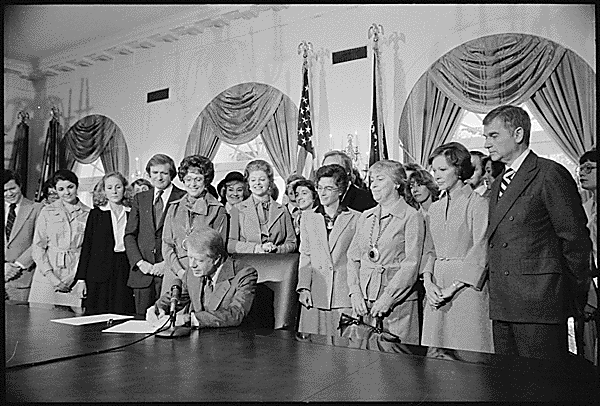WASHINGTON — Rep. Carolyn Maloney, D-N.Y., is leading a congressional charge for an equal rights amendment to enshrine gender equality in the U.S. Constitution as lawmakers in New York push for a broader measure on the same issue in the state Constitution.
The “inclusive Equal Rights Amendment” is “actually very, very different than the 45-year-old federal effort,” said state Sen. Liz Krueger, D-Manhattan, the lead sponsor. The state-level amendment would expand on the federal ERA language to include protections for race, ethnicity, national origin, sexual orientation, gender identity, gender expression and pregnancy.
The broad reach “would make New York state, I believe, the first in the nation to recognize that all of our populations should have nondiscrimination protections within our Constitution … (for) a broader universe of categories of humans and for a broader range of issues than gender,” Krueger said.
The proposal passed the state Senate last year but failed in the state Assembly. Krueger said both chambers have shown interest in passing the bill, “but we have not come to an agreement amongst ourselves on the language.”
She said the proposed amendment is a response to constituent demand and problems upholding equal rights legislation in the courts. “When you attempt to go to court to protect your rights, (that’s) when the metal meets the road about a Constitution.”
The state Senate has legislated on discrimination before but in practice, “there’s nothing in the Constitution that backs you up on that,” she said.
Latino populations, Krueger gave as an example, aren’t a race, but rather “people who have a common original language” – and so they fall out of constitutional protections against racial discrimination. “But we all know there’s discrimination based on being Black and brown in this country and the state,” Krueger said.
“That’s where it was clear that our very outdated New York state Constitution really didn’t have the language even to back up the individual laws that we had been passing.”
In order for the proposed amendment to succeed, identical bills must pass in the Senate and the Assembly in separate two-year sessions. She hopes to get passage in both chambers this year, at the end of this session, and again in the 2023-24 session.
If that works, it would go before New York voters on the November 2024 ballot.
Assemblywoman Rebecca Seawright, D-Manhattan, the lead sponsor of the bill in the Assembly, said, “we’re very close to getting an agreement with the state Senate,” but Krueger raised concerns about the ongoing debates over the amendment’s specific language.
The inclusion of and language related to certain protections – like religion – are still under debate, Krueger said.
Although “everyone agrees we must have protection from religious discrimination,” religion is a chosen practice in a way that race is not, Krueger said. She added those kinds of details are important when writing an actionable amendment; getting the language correct is key to creating strong legal footing for future legislation or any challenge in the courts.
“There’s all kinds of precedent that we need to make sure we have the language correctly on, that we are not impeding one right by protecting another right. So I have found that attempting a complex change in a Constitution is a much more difficult assignment than I had originally hoped for,” Krueger said.
“If we’re going to update the constitution on sex, then we needed to include these other classes that are overdue,” Seawright said.
Seawright, the former state director of the National Women’s Political Caucus in Texas, has worked with legal scholars and lawmakers pushing similar initiatives in other states, including Nevada, as well as with Maloney at the federal level.
Seawright’s 2019 resolution in the Assembly called on Congress to pass the ERA at the federal level.
“We’ve introduced that resolution again this session and will continue to until the federal government does pass an ERA,” Seawright said.
The federal effort to add an equal rights amendment for women to the U.S. Constitution has been in the works since the 1920s, explained Wilfred Codrington, an assistant professor at Brooklyn Law School and a fellow at the Brennan Center for Justice.
It passed the House and Senate in 1972 and was sent to the states for ratification – but it didn’t meet the ratification requirements of approval by three-fourths of the states until after a seven-year deadline had expired. New York ratified the amendment in 1972 — and Virginia became the 38th state to ratify the ERA in 2020.
Now, congressional lawmakers are pushing for the national archivist to acknowledge the ERA’s passage regardless of the deadline. Maloney’s office did not respond to requests for comment.
The reason for the urgency at the federal level is similar to that at the state level — women are protected by various laws, but “actually, none of that is permanent,” Codrington said.
Courts don’t need to stand by precedent “if there’s nothing permanent and enshrined in the Constitution protecting those values,” he said. “A number of statutes we’re seeing being contested in the courts and eviscerated or struck down that also were meant to be enduring,” including the Voting Rights Act that was challenged in Shelby County, Ala.
As it stands, “the Constitution doesn’t require women be treated equally,” Codrington said.
Seawright hopes New York’s efforts toward a state ERA “will serve as continued momentum for the Congress and the federal level to pass an equal rights amendment and that its potential presence on the 2024 ballot will be “a chance to educate” the public about the issues it addresses.
“And so here I am attempting to be a founding father/founding mother for our Constitution,” Krueger said. She believes New York’s efforts should be “a model and a target to get to at the federal level.”
On Monday, the New York State Bar Association is scheduled to host a webinar discussion on the push to include ERA language in the state Constitution. Krueger is one of the panelists.


